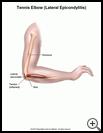
Tennis Elbow: Teen Version
What is tennis elbow?
Tennis elbow is inflammation of the bony bump at the outer side of the elbow, which makes the area painful and tender. The medical term for tennis elbow is lateral epicondylitis. It may also be called elbow tendinopathy or wrist extensor tendinopathy.
The elbow joint is made up of the bone in the upper arm (humerus) and one of the bones in the lower arm (ulna). The bony bumps at the bottom of the humerus are called epicondyles. The bump on the outer side of the elbow is called the lateral epicondyle. Forearm muscles that extend your wrist are attached to this bump by tendons.
How does it occur?
Among the activities that can cause tennis elbow are tennis and other racket sports, carpentry, machine work, computer work, and knitting. Tennis elbow results from overusing the muscles in your forearm that straighten and raise your hand and wrist. When these muscles are overused, the tendons are repeatedly tugged where they attach to the bone. As a result, the tendons get inflamed and torn.
What are the symptoms?
The symptoms of tennis elbow are:
- pain or tenderness on the outer side of the elbow
- pain when you straighten or raise your wrist and hand
- pain made worse by lifting a heavy object
- pain when you make a fist, grip an object, shake hands, or turn door handles
- pain that shoots from the elbow down into the forearm or up into the upper arm
How is it diagnosed?
Your healthcare provider will ask you about your activities. He or she will examine your elbow and arm. You may have X-rays of the elbow.
How is it treated?
Common ways to treat this injury are:
- Put an ice pack, gel pack, or package of frozen vegetables, wrapped in a cloth on the area every 3 to 4 hours, for up to 20 minutes at a time.
- You could also do ice massage. To do this, first freeze water in a Styrofoam cup, then peel the top of the cup away to expose the ice. Hold the bottom of the cup and rub the ice over your elbow for 5 to 10 minutes. Do this several times a day while you have pain.
- Wear a tennis elbow strap. This strap wraps around the forearm below the elbow and helps keep the forearm muscles from pulling on the painful epicondyle.
- Take an anti-inflammatory medicine such as ibuprofen, or other medicine as directed by your provider. Nonsteroidal anti-inflammatory medicines (NSAIDs) may cause stomach bleeding and other problems. These risks increase with age. Read the label and take as directed. Unless recommended by your healthcare provider, do not take for more than 10 days.
- Follow your provider’s instructions for doing exercises to help you recover.
- Your provider may give you an injection of a corticosteroid medicine.
In severe cases, surgery may be needed.
You will need to avoid or reduce activities that involve repetitive motion of the elbow (racket sports, hammering, or unscrewing jars) until your symptoms go away. You may need to run instead of play tennis. If you play tennis, you may need to use a tennis racket with a larger grip, or change the way you hold or swing your racket. Try to lift objects with your palm facing up to keep from overusing your lateral epicondyle.
How long will the effects last?
How long it takes to recover depends on your age and health, and if you have had a previous injury. Recovery time also depends on how severe the injury was. A mild injury may recover within a few weeks, but a severe injury may take 6 weeks or longer to recover. This problem may be long-lasting and can come back once you are better. You need to stop doing the activities that cause pain until your elbow has healed. If you keep doing activities that cause pain, your symptoms will return and it will take longer to recover.
When can I return to my normal activities?
Everyone recovers from an injury at a different rate. Return to your activities depends on how soon your elbow recovers, not how many days or weeks it has been since your injury. In general, the longer you have symptoms before you start treatment, the longer it will take to get better. The goal is to return to your normal activities as soon as is safely possible.
You may return to your sport or activity when you are able to forcefully grip things, like a tennis racket or golf club, or do activities such as working at a keyboard without pain in your elbow. It is important that there is no swelling around your injured elbow and that it is as strong as your uninjured elbow. You must have full range of motion of your elbow.
How can I prevent tennis elbow?
To prevent tennis elbow:
- Use proper form during sports or job-related activities. For instance, be sure your tennis racket has the proper grip size.
- Warm up before playing tennis or doing other activities that involve your elbow or arm muscles. Gently stretch your elbow and arm muscles before and after exercise.
- Put ice on your elbow after exercise or work.
- In job-related activities, make sure your posture is correct and that the position of your arms during your work doesn't stress your elbow or arm muscles.
Last modified: 2011-06-08
Last reviewed: 2009-12-28

